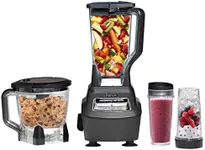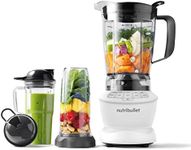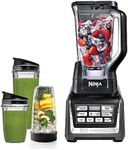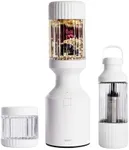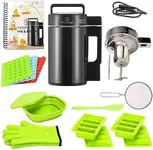Buying Guide for the Best Countertop Blenders
Choosing the right countertop blender can make a significant difference in your kitchen experience. Whether you're making smoothies, soups, or sauces, the right blender can help you achieve the perfect consistency and save you time. To find the best fit for you, it's important to understand the key specifications and how they align with your needs. Here are the main specs to consider when selecting a countertop blender.Power (Wattage)Power, measured in watts, determines how effectively a blender can crush and blend ingredients. Higher wattage means more power, which is essential for blending tough ingredients like ice, nuts, and fibrous vegetables. Blenders typically range from 300 to 1500 watts. For basic tasks like making smoothies or pureeing soft fruits, a blender with 300-600 watts is sufficient. For more demanding tasks like crushing ice or making nut butter, look for a blender with 1000 watts or more. Consider your typical usage to decide the right power level for you.
CapacityCapacity refers to the volume of the blender jar, usually measured in liters or cups. This determines how much you can blend at once. Blenders come in various sizes, from small personal blenders with 0.5 liters to large family-sized blenders with up to 2 liters or more. If you often make single servings or small batches, a smaller capacity blender will suffice. For larger families or batch cooking, a blender with a larger capacity is more practical. Think about the quantity of food or drinks you typically prepare to choose the right capacity.
Material of JarBlender jars are typically made from plastic, glass, or stainless steel. Plastic jars are lightweight and less likely to break, but they can absorb odors and stain over time. Glass jars are heavier and more durable, offering better resistance to scratches and stains, but they can break if dropped. Stainless steel jars are the most durable and can keep contents cooler, but they are opaque, so you can't see the blending process. Choose the material based on your preference for durability, weight, and visibility.
Speed SettingsSpeed settings allow you to control the blending process. Basic blenders may have just one or two speeds, while more advanced models can have multiple speed settings and pre-programmed functions. More speed options give you greater control over the texture and consistency of your blends. If you only need a blender for simple tasks, a few speed settings will suffice. For more versatility and precision, look for a blender with multiple speeds and pre-programmed settings tailored to specific tasks like smoothies, soups, or ice crushing.
Blade DesignThe design and quality of the blades are crucial for effective blending. Blades can be made from stainless steel or other durable materials and come in various shapes and configurations. Some blenders have multi-tiered blades for better blending efficiency. High-quality, sharp blades ensure smooth blending and can handle tough ingredients. If you plan to blend hard or fibrous ingredients frequently, look for blenders with strong, durable blades. For occasional use with softer ingredients, standard blades will be adequate.
Ease of CleaningCleaning a blender can be a hassle, so it's important to consider how easy it is to clean. Some blenders have dishwasher-safe parts, while others require hand washing. Blenders with removable blades and wide jar openings are easier to clean. If you use your blender frequently, look for models that are easy to disassemble and clean. For occasional use, ease of cleaning might be less of a priority, but it's still worth considering to ensure you maintain your blender in good condition.
Noise LevelBlenders can be quite noisy, which can be a concern if you have a quiet household or use your blender early in the morning. Noise levels vary between models, with some designed to operate more quietly. If noise is a significant concern for you, look for blenders that are specifically marketed as quiet or have noise-reducing features. For those who don't mind a bit of noise, this may not be a critical factor, but it's still worth considering for a more pleasant blending experience.



